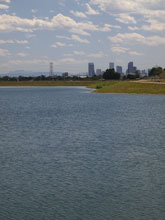
The Downstream Reservoir Water Storage Program, which has been under development since 1997, allows Denver Water to store and release water through the use of depleted gravel mines for exchange and replacement purposes.
Approximately half of Denver Water’s water supply is from the Colorado River. Because that water is not native to the Front Range, it may be used and reused multiple times, including storing it in the downstream reservoirs. When water is needed downstream by a more senior water right holder, Denver Water can then release the water stored in the downstream reservoir sand store a like amount in our mountain storage or divert it directly at our water treatment plant intakes. This operation is known as an exchange and helps meet customer demand, maintain water storage in our mountains reservoirs, and makes the most of the water we have.
Denver Water has been reusing water by exchange since the early 1970s. However, the Downstream Reservoir Water Storage Program increases the opportunity for Denver Water to put its reusable water supplies to use by first storing the water in the reservoirs and then releasing it when additional exchanges can be made.
At completion of construction, there will be nine reservoirs divided into three complexes, which will have an estimated total storage volume of 32,200 acre-feet of water. The reservoirs are along the South Platte River, north of Denver, and extend from Commerce City to Fort Lupton.
South Reservoir Complex
Bambei-Walker and Welby reservoirs, near Commerce City, form the South Reservoir Complex and began operation in spring 2009.
North Reservoir Complex
Denver Water continues to develop its North Reservoir Complex, which is south of 120th Avenue and east of the South Platte River. There are five reservoirs in this complex, including Howe-Haller A, Howe-Haller B, Hazeltine, Dunes and Tanabe. Denver Water began storing water in Dunes and Tanabe by gravity in spring 2018.
Mining has been completed in Howe-Haller A and Howe-Haller B and repairs to damage caused during the floods in 2013 and 2015, have been completed. Material removal at Hazeltine is ongoing but is expected to be completed prior to 2024. The remaining infrastructure, including the pump station and related electrical gear, are anticipated to be completed in early 2027.
Lupton Lakes Complex
Denver Water also continues to move forward on its third complex. The Lupton Lakes Complex, in Fort Lupton, is expected to be operational sometime after 2030. Lupton Lakes consists of two reservoirs, the north and south cells. Mining at the north cell has been completed and the liner has been installed; mining on the south cell continues, but the reservoir liner was completed using a groundwater cutoff wall. Construction of the inlet/outlet pipeline and river diversion structure is under way and is expected to be completed in 2022.
Water level fluctuations
Typically, all the reservoirs in the Downstream Reservoir Water Storage Program will be filled and drained on an annual basis. In general, these reservoirs will fill in the winter and drain in the summer, when downstream users — typically farmers — need water for irrigation.
